تثبيت التطبيق
How to install the app on iOS
Follow along with the video below to see how to install our site as a web app on your home screen.
ملاحظة: This feature may not be available in some browsers.
أنت تستخدم أحد المتصفحات القديمة. قد لا يتم عرض هذا الموقع أو المواقع الأخرى بشكل صحيح.
يجب عليك ترقية متصفحك أو استخدام أحد المتصفحات البديلة.
يجب عليك ترقية متصفحك أو استخدام أحد المتصفحات البديلة.
اسرائيل تطلب سربا اضافيا من الاف 15 النسر الصامت ..
- بادئ الموضوع صقر الامارات
- تاريخ البدء
هل النموذج هذا حقيقي ولاتصور للمشروع كمجسم؟الذيل بشكل V


بصراحه الاف16 فايبر و معها الادفنست سوبر هورنيت او الاستريك ايجل مثل النسخه السعوديه غير كده الامريكان في سلاح الجو تيرن اوفلو اسرائيل اخذت السايلنت ايجل + الجوينت
يبقى مخطط التطوير المصري مع الامريكان في الحسبان كذلك مما يعني الادفانسد سوبر هورنيت مكان الاف 16 او على اسوء الظروف الموافقة فعلا على تطوير الاف 16 لمعيار اعلى تسليحيا و تجهيزيا
انا ارى الموضوع ايجابي و ليس سلبي
هذا الي كنت خايف منه .. لا وبعد AN/APG-82 كملت ! .. انسوا الـDRFM والالغاء الايجابي معهم للاسف
هل النموذج هذا حقيقي ولاتصور للمشروع كمجسم؟
بروتوتايب على ما اظن انجزته بوينج لتعلن عن اشتقاق النسر الصامت ..
مش اوي كده ، ما انت مدخل رافال و ميج 35 و في اف 16 حديثبصراحه الاف16 فايبر و معها الادفنست سوبر هورنيت او الاستريك ايجل مثل النسخه السعوديه غير كده الامريكان في سلاح الجو تيرن اوف
انا بتوقع مش اكتر اصله لازم يكون في حسبانه توازنك مع اسرائيل و يكون متواجد في تسليحك بنسبة ايضا
اعتقد اقصى طموحنا لو حنعلا بالاماني استبدال الاف 16 القديم بالسوبر هورنيت مع الوقت و تطوير الاف 16 او لو هيا بايزة خالص و فعلا هيا كده تطوير الاف 16
بس ايا كان المخطط المصري حيدور على طائرة سيادة بنسبة اكتر دلوقتي
معلومه .. يمكن نزع الحاويات الداخلية وتركيب الاحمال الاعتيادية تماما مثل باقي الاف15 ..
لتقليل البصمة الرادارية ( للمهام التي تتطلب ذلك ) يتم حمل التسليح داخليا .. ولاحقا .. يمكن نزع الحاويات وحمل الحمولة الاعتيادية للسترايك ايجل
لتقليل البصمة الرادارية ( للمهام التي تتطلب ذلك ) يتم حمل التسليح داخليا .. ولاحقا .. يمكن نزع الحاويات وحمل الحمولة الاعتيادية للسترايك ايجل
مش اوي كده ، ما انت مدخل رافال و ميج 35 و في اف 16 حديث
انا بتوقع مش اكتر اصله لازم يكون في حسبانه توازنك مع اسرائيل و يكون متواجد في تسليحك بنسبة ايضا
اعتقد اقصى طموحنا لو حنعلا بالاماني استبدال الاف 16 القديم بالسوبر هورنيت مع الوقت و تطوير الاف 16 او لو هيا بايزة خالص و فعلا هيا كده تطوير الاف 16
بس ايا كان المخطط المصري حيدور على طائرة سيادة بنسبة اكتر دلوقتي
دول حيبقى عندهم تتش سكرين

منهم لله
هنا تلخيص لماتحتويه السايلنت ايجل
On Final
An aviation blog dedicated to military and civilian aircraft news, opinions and other related info.
On Final
An aviation blog dedicated to military and civilian aircraft news, opinions and other related info.
- JUL
17
F this and F that

F-15 Silent Eagle rendering
Now in the past I have mentioned the possibility of Canada purchasing some Boeing F-15 Silent Eagles but have generally been firm about the Super Hornet as my personal choice. In recent months however that has changed.
The F-35 is still being floated around as the ultimate answer to Canada's needs and with each passing day that an engine doesn't meet a fiery end it gains more and more popularity. Despite the very conservative estimate of a total cost of $45 billion over it's service life people still seem infatuated with it. Realistically that number will likely be closer to $70 billion and according to more than one private research finding, $100 billion. A very high cost to be sure.
Just for the sake of argument let's say the program costs $65 billion, that would equate to roughly $2,500 per taxpayer (26.1 million), at $45 billion that would drop to roughly $1,725 per taxpayer or $3,831 per taxpayer if it hit's $100 billion. That would work out to $127 per year at the top end and $57 at the bottom end of the scale.
Now let's look at the F-15 "Silent Eagle". Let's go with the Silent Eagle's projected cost of $100 million per airplane. Add to that $17,000 per flight hour (based on 2008 stats from report here) which is then multiplied by 8,000 flight hours (average based off of info found here) you get a lifetime service/maintenance cost of $13.6 million per aircraft which would bring that total to $884 million for 65 aircraft. So the new total for 65 aircraft would be about $7.38 billion total. So for fun let's just say other expenses I may have missed (I'll be the first to admit I'm no expert) bring that to $10 billion for life cycle costs. $10 billion divided 26.1 million ways comes to $383 per taxpayer over the lifetime (over 20 years roughly if I am not mistaken) which equates to about $1.60 per month per person. Not too bad when you think of the importance of Canada having a well equipped force of capable fighter jets.
Of course that is a very simplified look at costs to taxpayers and that would likely cost double for the average person and maybe even triple but the inadequacies of our tax system could fill another post quite easily so I'll leave it at that.
So, let's get to the fun stuff.
(photogriffon.com) F-15 going vertical
The F-15 is arguably the best fighter jet to ever be rolled out. It was built as a response to the Mig 25 Foxbat which was seen as a significant threat to the sluggish F-4 and with the F-14 being specialized for Naval use, the Air Force felt it would not be capable of accepting future upgrades (pretty good foresight when you think about it) so they opted for an aircraft that would be faster, more maneuverable and more advanced and when the dust settled they ended up with the F-15.
It was designed from the outset as an air-to-air specialist and it dominated the role. It could out-climb, out-turn and generally outdo any aircraft it came across. It also had an impressively long range.When the F-15E came online with air-to-ground focus it saw virtually no decline in it's dog fighting ability and it quickly gained a reputation as a competent fighter bomber. Add to that the F-15 airframes' ability to endure nearly 30,000 hours of hard abuse according to many reports and you have a durable and very lethal platform. Something that would do well in the harsh climates of this country's Arctic terrain which will make up the majority of the territory it patrols.
More recently, with the United States Air Force seeing less F-22's than planned and the issues with the F-35 it was decided that the F-15 would receive further upgrades to bring it up to date with the fifth-gen aircraft it would be expected to face going into the 2030's.
The platform is still more than capable of handling any aircraft it will come across. On that note, let's get right into the tech that the F-15 SE employs.
Joint Helmet Mounted Cueing System (JHMCS)
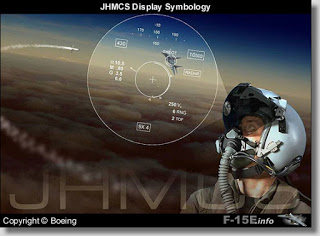
The JHMC is in use in various aircraft and has a 95% commonality between platforms. It is currently in use by the F-15, F-16, F/A-18 platforms and Boeing has awarded VSI a contract to provide the systems for Boeing's foreign military sales (FMS) program for Australia, Belgium, Finland, Canada and Switzerland.
While the system provides the aforementioned commonality between platforms it is only as advanced as the systems it is connected to which is what sets the F-15 apart from the other 4th generation aircraft.
For an excellent breakdown of the system itself, feel free to click the link here
Conformal Weapons Bays
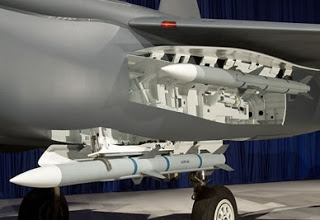
Example of Conformal Weapon Bays - Boeing
Externally mounted ordinance increases the radar cross-section (RCS) of an aircraft, so to make the Silent Eagle more stealthy and reduce it's RCS Boeing has designed these bays right into the conformal fuel tanks (CFT). Of course this also causes a fairly large reduction in combat radius (180-200 nm depending on the mission. These numbers are from Boeing based on ideal conditions and based upon the F110 GE-129 engines and would likely be reduced further in a dynamic real-world scenario.
The bright side to the design of the Silent Eagle's CWB's is that they affix to the aircraft in the same way the CFT's do so changing them out is relatively easy and the task can be done in about 2 hours, even in field conditions. An extra 1 hour of labor could see the underwing pylons reattached to the airframe granting space for another hardpoint and two more external fuel tanks.
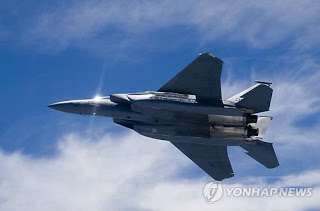
Silent Eagle rendering with CWB open - Unknown
This is handy as not every mission requires stealth and this allows the Silent Eagle to fly counter-air missions at the opening of a campaign and upon achieving air dominance it can be reconfigured for air-to-ground missions. In this theater the Silent Eagle will likely be stationed at a forward operating base so the reduced range isn't as big of a deal.
When the SIlent Eagle isn't in it's stealth configuration it performs exactly like the Strike Eagle.
Weapons

Silent Eagle internal weapon options - Boeing
In terms of air-to-air (A/A) ordinance, the Silent Eagle is capable of internally carrying the AIM-9 Sidewinder and the AIM-120 AMRAAM, one missile per CWB. The only AMRAAM missiles that can be carried are the AIM-120C or later. This is due to it's smaller wingspan which was designed with internal carriage in mind.
As far as air-to-ground (A/G) ordinance is concerned, the aircraft is capable of carrying 500 lb and 1000 lb JDAM bombs (also one per CWB) and the 250 lb GBU-39 SDB of which it can internally carry two per CWB.
In the event of a multi-role requirement the loadouts can be split between any of the aforementioned A/A and A/G weapons.and of course, when stealth is not a requirement it's loadouts can be matched to the Strike Eagle which will undoubtedly make up the bulk of it's roles within the RCAF.
Radar Absorbing Treatments
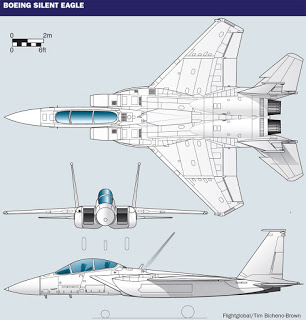
Silent Eagle layout - Boeing
The Silent Eagles' radar absorbent coatings are designed for A/A stealth against radars that operate in the X-band. The coatings also only influence the front-aspect stealth properties. In addition, one big aspect of the F-22 and F-35 is the extensive internal work done the structures to absorb and dissipate incoming radar energy. I haven't been able to find anything that confirms that Boeing has done this to the Silent Eagles' internal structure so that will also determine how effective the treatments on the Silent Eagle actually are.
Canted Tail Fins
The Strike Eagles tails are canted outward by 15 degrees which decreases RCS in A/A engagements. The outward cant also improves aerodynamic efficiency and generates extra lift. The canting also allows airframe weight to be reduced by removing 400-500 lbs of ballast weight from the forward section of the aircraft.
Radar, Electronic Warfare Systems and Sensors

APG-82 canted downward for improved efficiency - Raytheon
Now we get into the brains.
As far as Radar, the Silent Eagle is fitted with Raytheon's APG-82 active electronically scanned array (AESA) radar which is the newest version in their AESA line.
AESA radar uses beam technology instead of mechanical movement of the radar itself which enables faster and more accurate tracking over longer ranges and better overall situational awareness. The video by Northrop Grumman heregives a breakdown of it's AESA technology which gives a good example of how AESA works in general across all platforms that employ it.
The APG-82 implements the forward antenna from the APG-79 unit in the Super Hornets along with a modified back-end processor unit derived from the earlier APG-63(V)3. The APG-82(V)1 allows the Silent Eagle to detect and track multiple air and ground targets and threats near simultaneously (radar is stationary and doesn't need to be re-aimed) at far greater ranges than in the past.
The design of the APG-82 also improves reliability substantially and provides a large reduction in maintenance costs over older systems.
In order for Boeing to get the maximum amount of performance possible out of the APG-82 system it will remain canted forward despite the slight degradation to forward RCS.
----------------------------------------
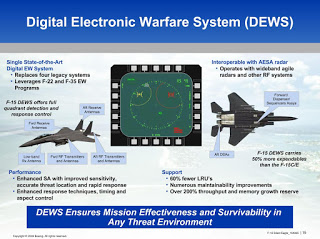
Instead of the tactical electronic warfare system (TEWS) in the Strike Eagle the Silent Eagle makes use of BAE's Digital Electronic Warfare System (DEWS)
DEWS uses digital radio-frequency memory (DRFS) technology which is said to have substantially better performance and reliability than the Analog TEWS system. The system has the ability to listen over a frequency band constantly without the need to scan it and the advanced antenna systems can obtain more accurate data with regards to the measurement of bearings. Targets acquired by the DEWS are fused with radar and infrared search and track (IRST) data and displayed on the large format cockpit displays.
The system was designed by implementing lessons learned during the development of the electronic warfare systems for the F-22 and F-35 JSF.
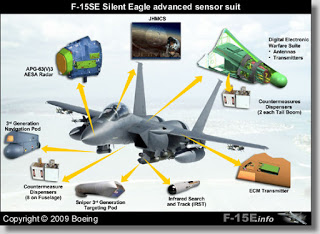
The system utilizes various sensors located in sections of the tail fins, wings and the underside of the airframe as well as a digital radar warning receiver (RWR). The Silent Eagle also contains an advanced jamming system which according to Boeing, allows the aircraft to jam enemy radar systems while still allowing it's own radar and RWR to operate.
The actual systems contained within the Silent Eagle make it more than capable of entering the battle arena with the best of Russia or anyone else.
All of these elements combine to make the F-15 platform an ideal candidate for the replacement of our current ageing CF-18 fleet.
To bring it all together you have arguably the best A/A combat aircraft ever conceived which is also an extremely capable A/G platform which has superior range and payload and is capable of reaching speeds of mach 2.5 or about 2,655 km/h. It is also incredibly durable as previously mentioned and in addition to the standard 8,000 hour service life it is capable of surviving up to 30,000+ hours. Given the harsh conditions that the Arctic it will routinely patrol is known for that durability is an incredible asset.
It also requires just 984' to takeoff and about 1,476' to land. It can also climb to it's maximum ceiling of 60,000 feet in just over 1 minute once airborne. This brings me to the final part of this post and that is the engines offered.

Boeing offers two engines for the Silent Eagle. The General Electric F110-GE-129 engines and the Pratt&Whitney F100-PW-220 engines. The above image shows the differences between the engine nacelles which is about the only way to tell them apart visually. Info on the GE-129 can be found here and a very detailed breakdown of the PW-220 can be found here.
Both engine types put out 29,000 lbs of thrust but do so in different ways. Both will have their own advantages and disadvantages but based on the popularity of the Pratt&Whitney offering which is also the widely accepted "standard" for the USAF I would assume that would be the best choice.
In terms of cockpit features and controls, the F-15 Silent Eagle features a digital flight control system (DFCS) which takes it from a semi fly-by-wire to a true fly-by-wire jet. This acts to reduce the weight on the stick and thus improve maneuverability and control while providing a boost to system reliability.
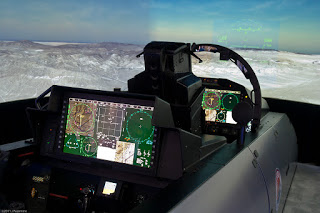
Silent Eagle updated cockpit design - Boeing
As for the cockpit not much has been made available by Boeing. It will presumable have three multi-function LCD displays for the pilot and four similar displays for the weapons systems officer (WSO) like the current F-15 Strike Eagle layout according to the Boeing sourced picture to the left.
Of course, the F-15 platform overall has proven itself over and over again and if we're serious about moving into the fifth generation to enable us to defend better against increasing threats from Russia and China we would do well to acquire the Silent Eagle.
Given our close ties to the United States I imagine we could probably even get better features than most other export countries and the assembly line will be running until at least 2018 so there isn't the same threat of things drying up that exists with the Super Hornet and Eurofighter platforms.

CF-18 Intercepting Russian "Bear" over Arctic - unknown
You have to keep in mind that the general role of our aircraft is the defense and policing of our territory particularly in the arctic where Russia routinely breaches our airspace. Given the F-15 can fly substantially faster and farther than the Hornet and Super Hornet, can carry more payload and has the power and maneuverability to tangle with any threat it faces. As a result it can respond to and intercept threats much quicker and much more effectively than any Hornet platform and it's 1,500' landing requirement puts it in good shape if it ever had to land at one of our Arctic Forward Operating Bases (FOB) in an emergency.
Add to that the new platforms enhanced electronic warfare systems and sensors which are a claimed match for the F-22's systems and you have the perfect answer going forward. At minimum the platform will last to 2035 (limited by electronics) and based on current airframe life-cycle stats could push well into the 2040's.
Unlike the F-35 it is also a completely proven platform with a legendary track record to back it up. So for a lifetime cost (20-30 years assumed) of about 400-650 dollars per taxpayer in this country we can get a fifth-gen capable 4th gen fighter with everything we need to defend our airspace from current and future threats and still provide inter-operability with allied operations.
So what are we waiting for?
------------------------------------------------------------------------------------------------------------------------------------------
Some sources of info which were tapped:
F-15E.info - Fantastic resource for information on the F-15 platform.
Axle Geeks F-15 Profile - F-15 performance info at a glance and ability to compare with other aircraft.
BAE Systems EW - BAE Systems info on their range of Electronic Warfare offerings.
F-15 and F-22 Myths/Facts - PDF written in response to challenges and contains updated maintenance info.
GS F-15 Service Life breakdown - Global Security breakdown of F-15 service life.
Northrop-Grumman EPAWSS - The Eagle Passive/Active Warning & Survivability System (EPAWSS)
GS AN/APG-82(V)1 Info - Global Security document on the Raytheon AN/APG-82(V)1 AESA radar
Saudi F-15 SA Info - Defense Update info on the Saudi F-15 SA acquisition
Air Force Update of F-15 Radars - DOD Buzz posting on USAF F-15 radar upgrade
Boeing Radar Contract - Aviation Week article on the selection process for the EPAWSS contractor
Posted 17th July by Chris Black
Labels: AESA BAE Systems boeing Canada CF-18 electronic warfare EPAWSS F-15 F-22 F-35 Radar Raytheon silent eagle
معلومه .. يمكن نزع الحاويات الداخلية وتركيب الاحمال الاعتيادية تماما مثل باقي الاف15 ..
لتقليل البصمة الرادارية ( للمهام التي تتطلب ذلك ) يتم حمل التسليح داخليا .. ولاحقا .. يمكن نزع الحاويات وحمل الحمولة الاعتيادية للسترايك ايجل
اعتقد الاسرائيلين سينظرون لكونفجريشن مشابه للسعودي تماما الفارق فقط استغلال ال RCS القليل من السايلنت ايجل
لكن الدور الرئيسي لها هو plain and obvious hunter killer و الجوينت لفتح الثغرات البسيطة لتكمل الاف 15 الطرق الثقيل مع الصوفا
اصل المشرحه ناقصه قتله
باتش اضافي من الرافال + كام بطاريه تريموف + كاراسوخا
اقل من كده مش هينفع .. خااالص
باتش اضافي من الرافال + كام بطاريه تريموف + كاراسوخا
اقل من كده مش هينفع .. خااالص
دول حيبقى عندهم تتش سكرين

منهم لله
ايه المشكلة حنزل ايفون 6s للطيارين عليه app : HTK
كفاية يا استاذ كاميكازي الواحد متعقد خلقة
عموما الكابين لكل الطائرات الحديثة الامريكية كده من جوينت لسيلنت حتى الادفانسد هورنيت و اتوقع في نسخة من الاف 16 نفس الشئ
عموما عندما تدفع بتوازن مل لمرحلة متقدمة لابد ان تدفع بقية عناصر التوازن .. السعودية done ... مصر تقريبا done .... الكويت تقريبا done كذلك قطر .... في انتظار الامارات
اعتقد الاسرائيلين سينظرون لكونفجريشن مشابه للسعودي تماما الفارق فقط استغلال ال RCS القليل من السايلنت ايجل
لكن الدور الرئيسيس لها هو plain and obvious hunter killer و الجوينت لفتح الثغرات البسيطة لتكمل الاف 15 الطرق الثقيل مع الصوفا
السؤال الابرز ..
هل سيتبنون التعديل الهندسي للذيل .. V SHAPE
ام سيكتفون ببقية التعديلات الاخرى ..
علشان كده ذكرت الاسترايك ايجل و في حاله الرفض لا بديل عن صفقه سو35 باعداد محترمهمش اوي كده ، ما انت مدخل رافال و ميج 35 و في اف 16 حديث
انا بتوقع مش اكتر اصله لازم يكون في حسبانه توازنك مع اسرائيل و يكون متواجد في تسليحك بنسبة ايضا
اعتقد اقصى طموحنا لو حنعلا بالاماني استبدال الاف 16 القديم بالسوبر هورنيت مع الوقت و تطوير الاف 16 او لو هيا بايزة خالص و فعلا هيا كده تطوير الاف 16
بس ايا كان المخطط المصري حيدور على طائرة سيادة بنسبة اكتر دلوقتي
لا أعتقد أنها ستكون F-15SE. هذا الأمر مستبعد جداً وتم إيقاف كامل البرنامج.
المقاتلة حتى الآن لم تنهي جزءاً كبيراً من الإختبارات, توقفت إختباراتها عند إطلاق أنواع معينة من الذخائر.
بقية الإختبارات تم إيقافها حتى شعار آخر لعدم وجود مشتري محتمل.
المصدر ذكر Silent Eagle على سبيل التخمين حيث أنها تمثل أحد أحدث الإصدارات لمقاتلة F-15.
على الأغلب ستكون مقاتلة F-15I Ra'am بإلكترونيات طيران محدثَة.
المقاتلة حتى الآن لم تنهي جزءاً كبيراً من الإختبارات, توقفت إختباراتها عند إطلاق أنواع معينة من الذخائر.
بقية الإختبارات تم إيقافها حتى شعار آخر لعدم وجود مشتري محتمل.
المصدر ذكر Silent Eagle على سبيل التخمين حيث أنها تمثل أحد أحدث الإصدارات لمقاتلة F-15.
على الأغلب ستكون مقاتلة F-15I Ra'am بإلكترونيات طيران محدثَة.
دليل على عدم جهوزية الأف 35
الايقل فعلا طائرة مذهله ولا تشيخ ابدا
اسرائيل تدرك بصورة كبيرة قدرات الاف35 .. انظر لطلبها
Israel to request exclusive use of F-35 in Middle East
https://www.flightglobal.com/news/a...st-exclusive-use-of-f-35-in-middle-ea-417144/
طلبت ان تكون المستخدم الحصري لها في الشرق الاوسط .. هذا احد مؤشرات ثقتهم بقدراتها ونضجها القادم ..
المشكلة حنلاقي اجيال الذخائر الاسرائيلية و الامريكية الحديثة بالكامل و افتح قوص و ابدا من ال SDB 2 و الاجيال الشبحية من الذخائر الستاند اوف
ال APG/81 وش
DEWS / DAS و ما الا ذلك من مقبلات
اتوقع البيت حتنزل بتصور التشويش الشبكي الخاص بيها عليها
لازلت لا ارى ال RCS بقيمة كبيرة هنا ، هي اداة طحن مثلها مثل الراعم لذا مسالة المواجهة لن تكون قضية
المشكلة خطوات التطوير المماثلة على الاقل كا مصر
ال APG/81 وش
DEWS / DAS و ما الا ذلك من مقبلات
اتوقع البيت حتنزل بتصور التشويش الشبكي الخاص بيها عليها
لازلت لا ارى ال RCS بقيمة كبيرة هنا ، هي اداة طحن مثلها مثل الراعم لذا مسالة المواجهة لن تكون قضية
المشكلة خطوات التطوير المماثلة على الاقل كا مصر
ايه المشكلة حنزل ايفون 6s للطيارين عليه app : HTK
كفاية يا استاذ كاميكازي الواحد متعقد خلقة
عموما الكابين لكل الطائرات الحديثة الامريكية كده من جوينت لسيلنت حتى الادفانسد هورنيت و اتوقع في نسخة من الاف 16 نفس الشئ
عموما عندما تدفع بتوازن مل لمرحلة متقدمة لابد ان تدفع بقية عناصر التوازن .. السعودية done ... مصر تقريبا done .... الكويت تقريبا done كذلك قطر .... في انتظار الامارات
الامارات تنتظرها استحقاقات كبيرة ( استبدال الميراج واحتمالية اضافة 30 مقاتلة اخرى .. ربما زيادة على الشق الامريكي )
ترقبوا دبي للطيران 2015 الاسبوع القادم .. يوم الاحد
لربما تكون هناك مفاجآت كبيرة
المواضيع المشابهة
- الردود
- 50
- المشاهدات
- 6K
- الردود
- 15
- المشاهدات
- 2K
- الردود
- 11
- المشاهدات
- 2K
- الردود
- 3
- المشاهدات
- 458

